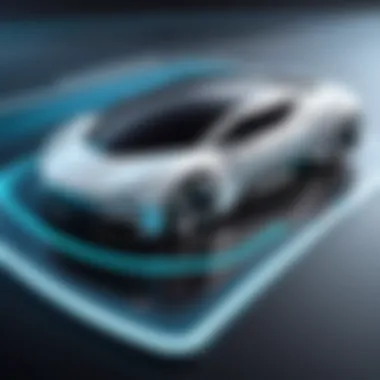Exploring the Future of Automobiles and Mobility


Intro
The automobile has been a game-changer since its inception, and its evolution feels like riding an exhilarating roller coaster. Each twist and turn has brought about groundbreaking innovation, societal shifts, and increasing awareness regarding environmental sustainability. Today, you might find yourself pondering questions about self-driving cars or the rise of electric vehicles. How will these changes redefine our relationship with mobility, and what lies ahead?
This narrative seeks to explore an intricate tapestry of automotive advancements, focusing on technology, eco-friendly solutions, and the societal landscapes shaping vehicles of tomorrow. Buckle up as we dive into the realm of automotive evolution, charting a course through shifting trends and innovations that are fundamentally reshaping transportation.
Technology Insights
Latest Tech Trends
The automotive industry is buzzing with tech rats making significant strides. Think about it: nearly every vehicle on the road is being infused with smart technologies. From adaptive cruise control to comprehensive infotainment systems, the cars of today are packed with tech features that would have seemed like science fiction just a decade ago. Notably, the integration of artificial intelligence plays a vital role in shaping these trends.
- Self-driving capabilities are not just a distant dream anymore; companies like Tesla and Waymo have set the stage for autonomous vehicles that challenge conventional driving norms.
- Connectivity features are becoming increasingly common, allowing cars to communicate with each other and infrastructure, paving the way for smarter urban environments.
Innovation in Tech
Manufacturers are not simply slapping tech into vehicles; they’re rethinking the entire driving experience. Innovation is the name of the game. Take Rivian, for instance, which is spearheading an electric pickup revolution. Their R1T is a sturdy runner, marrying powerful performance with eco-conscious design.
Electric vehicles, or EVs, are no longer niche players in the auto world. Brands such as Ford with its Mustang Mach-E and Mercedes-Benz with the EQ series are pushing boundaries. With exhilarating performance and minimal emissions, these vehicles not only cater to the environmentally-conscious buyer but also appeal to thrill-seekers.
Product Reviews
While the prospect of electric and autonomous vehicles sparks interest, detailed reviews provide deeper insights into specific models that stand out:
- Tesla Model 3: A benchmark for electric sedans offering impressive range, tech-rich cabin, and an exhilarating acceleration that leaves gasoline competitors in the dust.
- Ford Mustang Mach-E: Combining sports car aesthetics and electric performance while ensuring practicality and spaciousness.
"The future of automobiles is not just about transportation; it's about transforming how we interact with our world and influencing societal norms."
The advent of advanced driver assistance features and mobile apps has further transformed the relationship between users and their vehicles. Drivers can now access information about their vehicle's performance, schedule maintenance, or even find nearby charging stations, all with the tap of a finger.
As technology blazes forward, it’s crucial to stay updated on these trends. Understanding the tech landscape can help automotive enthusiasts make informed decisions when choosing their next vehicle.
End
The road ahead for the automotive industry promises a blend of technology, sustainability, and innovation. As cars become increasingly smart and environmentally friendly, the driving experience will change dramatically. Now's the time for both consumers and manufacturers to embrace this evolution and keep their eyes firmly planted on the horizon.
Technological Advancements Transforming Automobiles
The automotive landscape is undergoing a seismic shift fueled by rapid technological advancements. This transformation is not merely a trend; it represents a profound evolution that impacts how we view transportation. Innovations like autonomous driving, electric vehicles, and connectivity features hold the promise of redefining our journeys on the road and influencing broader societal changes.
The Rise of Autonomous Driving
The concept of autonomous driving is no longer confined to science fiction films. Companies such as Tesla and Waymo have led the charge into creating vehicles that can navigate without human intervention. The primary benefit of autonomous technology is enhanced safety—removing human error from the equation may substantially reduce accidents and fatalities. However, it brings forth a slew of considerations; ethical dilemmas arise regarding decision-making in critical situations, and regulatory frameworks are yet to catch up. At its core, this advancement, while offering significant potential, challenges our traditional understanding of vehicle control and responsibility.
Electric Vehicles and Battery Technology
Current Market Leaders
Leading the charge in the electric vehicle realm are giants like Tesla and Nissan. Their contributions are nothing short of revolutionary, providing vehicles that are both eco-friendly and high-performance. The strong appeal of these market leaders lies in their ability to combine cutting-edge technology with sustainable practices. Tesla's Model 3, particularly, has garnered attention for its impressive range and acceleration. However, these vehicles often come with a premium price tag, which can be a barrier for some consumers. As charging infrastructure expands, these brands are forging a path toward acceptance in the mainstream market.
Future Innovations in Battery Life
Innovations in battery technology are driving electric vehicles into a brighter future. Solid-state batteries, for example, promise significant advancements over more conventional lithium-ion batteries. Their higher energy density can lead not only to longer driving ranges but also to shorter charging times. As these technologies mature, we may witness a tipping point where electric vehicles become the predominant choice for consumers. The trade-off, however, lies within the initial research and development costs as well as the still-unproven longevity of these batteries in everyday use.
Connectivity and Smart Features
Integration with IoT


The incorporation of the Internet of Things (IoT) into vehicles adds layers of convenience previously unimaginable. Automobiles can now communicate with various digital devices, enabling features like remote diagnostics and real-time traffic updates. This connectivity trend not only enhances the driving experience but also improves overall vehicle efficiency. Yet, the flip side is the potential for cyber threats. As vehicles become more connected, the risk of hacking increases, necessitating robust cybersecurity measures. Therefore, while IoT integration offers immense benefits, it also requires a careful approach to security.
Vehicle-to-Vehicle Communication
Vehicle-to-vehicle (V2V) communication is another fascinating development that stands to revolutionize road safety. By sharing data about speeds, weather conditions, and traffic signals, cars can essentially collaborate to avoid collisions or gridlocks. This capability could dramatically reduce accident rates and improve overall traffic flow. However, implementing this technology will require significant investment in infrastructure and public acceptance of data-sharing norms. It is a balancing act between technological progress and privacy concerns.
The future of transportation is not just about getting from point A to point B; it’s about how we arrive there together—safely, efficiently, and sustainably.
As we navigate this evolving terrain, it's clear that technological advancements in the automotive world are reshaping our interactions with our vehicles and each other; yet, they call for a dialogue on the associated challenges. Understanding these dynamics will be crucial for all stakeholders involved, from manufacturers to consumers.
Environmental Impact and Sustainability
The automobile industry significantly influences our environment. As society advances, it becomes crucial to address environmental concerns inherent in vehicle production and usage. The sector's impact stretches across carbon footprints, resource depletion, and pollution, necessitating a transformation towards sustainable practices. Not only is this shift vital for mitigating climate change, but it also represents an opportunity to innovate and create vehicles that are more in harmony with nature. Manufacturers are recognizing that sustainability isn’t just a trend; it's a responsibility. This section examines key aspects of environmental impact while spotlighting the urgency for sustainable solutions in the automotive realm.
Carbon Emissions and Climate Change
The issue of carbon emissions is front and center in today’s discussions about climate change. Every vehicle on the road contributes to the overall greenhouse gas emissions, which trap heat in our atmosphere and escalate the climate crisis. Traditional internal combustion engines are notorious for their carbon output. In essence, the longer we rely on these vehicles, the higher the stakes for our planet’s health. For instance, a standard gasoline car can emit multiple tons of carbon dioxide per year.
Reducing these emissions requires a strategic overhaul in how we perceive transportation. Transitioning to electric vehicles, adopting hybrid solutions, and promoting public transportation can significantly lower global emissions. Automakers that embrace these alternative energy sources are not only responding to regulatory pressures but also tapping into a growing market of eco-conscious consumers.
Sustainable Manufacturing Practices
Recycling and Materials Innovation
Innovative recycling methods are emerging as a core part of sustainable manufacturing in the automobile industry. Recycling not only reduces waste but also curbs the demand for new raw materials, which is a win-win in environmental terms. For example, using recycled aluminum in vehicle production saves up to 95% of the energy required to create new aluminum. This efficiency not only saves costs but also diminishes the industry's overall carbon footprint.
The distinctive characteristic of recycling is that it fosters a circular economy—whereby products are continually repurposed instead of being thrown away after their first life cycle. Moreover, introducing sustainable materials, like bio-composites or natural fibers, into car interiors presents an alternative to traditional petroleum-based components. This approach can reduce reliance on fossil fuels and contribute to a cleaner environment.
However, the challenge lies in the infrastructure for recycling and consumer acceptance. While many auto manufacturers are shifting towards recycled materials, they must educate consumers on the benefits and reliability of these innovations. This step is pivotal in creating public trust in the sustainability of vehicles made from recycled components.
The Role of Renewable Energy
Renewable energy is a game-changer for the automotive industry. As electric vehicles proliferate, the energy source powering these machines becomes a critical factor. If our electricity is sourced from fossil fuels, we still have an uphill battle in reducing overall carbon emissions. But an infusion of renewable energy into our grids—think wind, solar, and hydro—can dramatically shift this narrative.
In this landscape, partnerships between automobile manufacturers and renewable energy suppliers are becoming commonplace. Some electric vehicles are now equipped with solar panels, giving them the ability to harness energy directly from the sun. This innovation not only increases efficiency but also reduces dependency on conventional electricity.
Furthermore, as more consumers install home solar systems, the potential for decentralized energy sources grows. This can lead to significant savings for consumers, making renewable-energy solutions more attractive in the long run. Thus, integrating renewable energy into the automotive framework does not just address environmental goals, it also aligns with consumer desires for energy independence and sustainability.
"Future automotive innovations hinge on the convergence of renewable energy and sustainable manufacturing—an intersection that promises to reshape the industry."
Shifting Consumer Preferences
In the ever-evolving landscape of the automotive industry, understanding shifting consumer preferences stands as a pillar of future developments. As we navigate through the complexities of modern transportation, it becomes clear that consumer choices are not just about the vehicles we drive. These shifts reflect deeper trends, including environmental concerns, technological advancements, and lifestyle changes.
The importance of shifting consumer preferences lies in their ability to drive market demand and influence manufacturing practices. For example, buyers are becoming increasingly conscious of their carbon footprints, which elevates the demand for electric and hybrid vehicles. Simply put, the decisions of consumers directly guide automakers’ strategies. When auto manufacturers respond proactively to these preferences, they can gain a competitive edge, aligning themselves with a consumer base that continually seeks innovation and sustainability.
The Demand for Electrification
One striking characteristic of current automotive trends is the rising demand for electrification. Consumers are shifting away from traditional gasoline-powered cars, pushing electrification to the forefront. Several factors contribute to this trend: rising fuel prices, greater awareness of environmental issues, and advancements in electric vehicle technology.
Notably, cities are implementing stringent emission regulations, compelling buyers to consider electric alternatives over conventional vehicles. Moreover, the improvements in battery technology have significantly reduced concerns about range anxiety. Thus, electrification is not merely a fad but a critical element of the future of automobiles.
Changing Ownership Models
The ownership models for vehicles are also undergoing substantial transformation. As urban settings become more congested, many individuals are reconsidering the necessity of owning a personal vehicle. This change is marked by the rise of car-sharing and ride-hailing services.
Car-Sharing and Ride-Hailing Services


Car-sharing and ride-hailing services, such as Uber and Zipcar, represent a marked shift in how society views vehicle ownership. These services enable users to access a vehicle without the long-term financial commitment of ownership. This flexible approach appeals greatly to young professionals and urban dwellers who value convenience and cost-efficiency.
The key characteristic of car-sharing services is their ease of use. Users can simply book a car via an app and have access to different models as per their requirements. Like unlocking a door, it fits seamlessly into today’s on-demand economy. However, it does come with certain drawbacks. For instance, there may be limitations on vehicle availability, or users could face surge pricing during high-demand periods. Still, many find that the benefits, such as reduced maintenance worries and insurance costs, outweigh these inconveniences.
Subscription Models
The concept of subscription models is yet another way consumer preferences are reshaping the automotive landscape. This approach allows individuals to pay a monthly fee for access to a vehicle, often with different models to choose from. Think of it like a Netflix subscription—only now you’re cruising down the road in style.
The appeal of subscription models lies in their flexibility and simplicity. No more worries about depreciation or long-term commitments. Subscribers can easily switch vehicles as needed, perfect for those who favor variety. However, the cost can be relatively higher compared to traditional ownership in the long run, which might deter budget-conscious consumers.
"The future of mobility will not just be about the cars we drive but also how we access them."
The interplay between electrification, changing ownership models, and consumer demands will dictate the success of automotive innovations moving forward.
Regulatory and Policy Frameworks
The automotive industry finds itself at a crossroads, where innovation meets regulation. Regulatory and policy frameworks are crucial in shaping the future of automobiles. They ensure that advancements in technology are safe, sustainable, and beneficial for society. They also highlight the importance of standards that manufacturers must meet, ensuring that cars on the road align with environmental and safety goals. As the industry evolves, it's imperative to understand these frameworks as they can stimulate innovation while also protecting consumers and the environment.
Legislation Influencing Automotive Innovation
Safety Standards for Autonomous Vehicles
Safety standards are non-negotiable in the development of autonomous vehicles. These regulations focus on various aspects, including testing protocols, operational design domains, and minimum safety performance measures. One key characteristic of safety standards is their ability to build public trust in self-driving technology. Without rigorous standards in place, consumers may be hesitant to embrace vehicles that drive themselves, as there's always a lingering doubt about safety outcomes.
Moreover, these standards foster competition among companies, raising the bar for innovation. The unique feature here is that they not only ensure the vehicles are safe for consumers but also facilitate the deployment of these advanced technologies on a large scale. However, one challenge could be the pace of these regulations which might lag behind the rapid technological advancements. This slow adaptation could stall innovation, creating a tug of war between regulation and development.
"Safety regulations are not just checks in a box; they are foundational to the very trust we place in autonomous vehicles."
Impact of Emission Regulations
The impact of emission regulations on vehicle development cannot be overstated. These regulations push manufacturers to reduce their carbon footprint, aligning vehicle production with environmental goals. This drives innovation in cleaner alternatives like electric and hybrid models. A key characteristic of emission regulations is their consistency across regions, yet they can vary widely from country to country. For example, stringent CO2 emission targets in Europe contrast sharply with more lenient standards in some regions of the U.S.
Here's where it gets interesting—the unique aspect of these regulations is the positive feedback loop they create. As manufacturers develop greener technologies to comply with regulations, they often discover new efficiencies and cost savings that can be passed to consumers. However, there are disadvantages too; constantly changing regulations can pose a serious challenge for manufacturers trying to keep up. The pressure to innovate can sometimes lead to increased costs, which could be passed down to buyers.
Government Incentives for Electric Vehicles
Government incentives play a pivotal role in promoting electric vehicles, acting as a catalyst for widespread adoption. These incentives can range from tax credits and rebates to reduced registration fees, making electric vehicles more attractive to buyers. Such measures can greatly enhance the market appeal of electric automobiles, especially against traditional gasoline-powered vehicles.
Moreover, incentives not only motivate consumers but also encourage manufacturers to invest in electric vehicle research and development. The unique feature of government incentives is their ability to complement regulatory frameworks. When strict emissions standards are coupled with financial incentives, it creates a conducive environment for transitioning to electric mobility. However, the challenge remains: as governments often review these perks, the uncertainty can impact consumer confidence. Thus, the future of these incentives must be closely monitored to maintain momentum in the shift toward electric vehicles.
Global Market Dynamics
An analysis of global market dynamics offers a crucial lens through which to understand the rapidly changing landscape of the automotive sector. This aspect of the article delineates how various factors—from economic growth to consumer behavior—intertwine to shape not just local markets but also the international automotive sphere. The significance of this topic cannot be overstated; it opens up avenues for informed predictions regarding future trends and highlights emerging opportunities that stakeholders can tap into. Furthermore, discerning these dynamics aids manufacturers, policymakers, and consumers alike to navigate the complexities of automotive innovation and development.
Regional Trends in Automotive Development
North America
In North America, one significant characteristic is the robust infrastructure that supports an extensive automotive ecosystem. This region is home to some of the largest automotive manufacturers, such as General Motors and Ford, which contribute vastly to innovation and employment. The focus on electric vehicle adoption has gained momentum, propelled by consumer awareness of environmental issues and incentives offered by governments. However, while North America boasts advanced research facilities, it faces challenges such as stringent regulations that can slow down the pace of innovation. The competition is intense, pushing legacy companies to adapt quickly or risk losing market share to emerging players who are more agile.
Europe
Europe stands out for its progressive policies geared towards sustainability and emissions reduction. Countries like Germany and Sweden lead the charge in promoting electric vehicle technology, many consumers in Europe actively seek out greener options. The European market is characterized by a strong commitment to reducing carbon footprints, which serves as a significant driver for the automotive industry's evolution. The regulatory environment, while strict, is designed to foster innovation, yet it can pose hurdles for new entrants who must navigate complex compliance landscapes. The focus on luxury and high-performance electric vehicles also sets Europe apart, making it a beacon for tech-savvy consumers and environmentally conscious buyers alike.
Asia-Pacific
The Asia-Pacific region is pivotal in the global automotive landscape, often seen as a melting pot of innovation and mass production. China, in particular, is the world's largest market for electric vehicles, fueled by government initiatives and a growing middle class eager to embrace the latest technology. The reliance on advanced manufacturing techniques allows for rapid scaling that many Western manufacturers cannot match. Nevertheless, it is not without its problems; the fierce competition among domestic firms can lead to uncertainties regarding quality and sustainability, which can undermine consumer trust. Still, the immense potential here offers a treasure trove of emerging opportunities to both local and international stakeholders.


Emerging Markets and Opportunities
Emerging markets represent a significant area for growth in today's automotive industry. As economies develop, there’s a growing need for personal transportation options, coupled with an increasing appetite for innovation. Many rapidly growing countries are investing heavily in infrastructure improvements while also seeking solutions that balance economic growth with environmental sustainability.
- Electric Vehicle Push: Nations in Southeast Asia are gearing up to boost their electric vehicle infrastructure.
- Adoption of Ride-sharing Services: In regions such as Africa and parts of Latin America, the rise of mobile technology is driving the popularity of ride-sharing platforms, reshaping traditional ownership models.
"Emerging markets are not just a breeding ground for low-cost vehicles; they can also lead the charge in tech adoption if approached thoughtfully."
Opportunities abound in this arena. With changing consumer dynamics and an influx of investment, the next wave of automotive innovation could very well rise from unexpected corners of the world, creating a truly global marketplace for cars.
Challenges Facing the Automotive Industry
In the rapidly evolving automobile sector, challenges are aplenty. These obstacles are not merely bumps in the road; they are significant hurdles that require innovative solutions and strategic thinking. Addressing these challenges is crucial for ensuring the industry's sustainable growth and development. The focus here is twofold. First, technological barriers and cybersecurity threats require immediate attention. Second, the need to transition to sustainable practices is imperative not only for compliance with regulations but also for bolstering consumer trust and loyalty.
Technological Barriers and Cybersecurity
As automobiles integrate increasingly sophisticated technology, they face a series of barriers that can impede progress. Some manufacturers may find themselves caught in a web of outdated systems or legacy software that cannot support the latest advancements. The integration of autonomous capabilities, for example, necessitates seamless software updates and hardware compatibility.
On the flip side, cybersecurity looms large in this landscape. With vehicles becoming more connected, they are also becoming more vulnerable to cyber threats. Hackers targeting vehicle systems can gain access to sensitive data or even control vehicle functions. Reports of such incidents have sent shockwaves through the industry.
- Critical areas at risk include:
- Navigation systems
- Infotainment systems
- Vehicle-to-vehicle communication
To counter these threats, companies must invest significantly in research and development, establishing robust cybersecurity protocols. Addressing these issues not only protects consumer safety but also preserves brand reputation.
The Transition to Sustainable Practices
The road to sustainability is paved with its own set of challenges, yet it's an unavoidable journey for the automotive industry. Companies are increasingly pressed to adopt eco-friendly practices, not only due to regulations but also consumer demand for greener products. The push for electric vehicles is just the tip of the iceberg. Modern challenges include:
- Material Sourcing: Finding sustainable materials that do not compromise on performance or safety can be taxing.
- Manufacturing Processes: Transitioning to a manufacturing model that minimizes waste and energy consumption is complex and requires systemic changes.
Moreover, maintaining profitability while pivoting towards sustainability can be a tightrope walk for manufacturers. Firms that embrace this transition, however, may well position themselves as leaders in an eco-conscious market. > "Companies that take sustainable practices seriously will not only meet regulations but also thrive in a market increasingly driven by consumers' green priorities."
Engaging actively with consumers to educate them about these sustainable efforts can further solidify brand loyalty.
Navigating these challenges is no simple feat, but they present an opportunity for the industry to reinvent itself, blending tradition with innovation to forge a path toward a cleaner and more connected future.
The Future of Mobility
The automotive landscape is on the brink of a transformation that could redefine how we understand mobility. As cities become more congested and environmental concerns take center stage, the future of mobility becomes not just a buzzword but a necessity. This section explores various aspects of mobility, emphasizing urban solutions and the collaboration between public transport and personal vehicles.
Urban Mobility Solutions
Urban mobility solutions are crucial for addressing challenges that urban centers face today. Traffic congestion is a significant issue; it slows commuters, increases air pollution, and reduces the overall quality of city life. Cities are often designed for cars, but not everyone owns one. This gap presents an opportunity for innovation.
Solutions like bike-sharing systems, electric scooters, and car-pooling services are mushrooming in cities worldwide. These solutions not only provide alternatives to car ownership but also work towards reducing carbon footprints. For example, communities that promote bike lanes and pedestrian-friendly zones encourage a more sustainable approach.
Moreover, technology plays a vital role in enhancing urban mobility. Mobile applications connect commuters to various transport modes, allowing users to plan multi-modal journeys efficiently. These digital platforms can provide real-time updates on public transport schedules and availability, making it easier for people to opt for public transport over personal vehicles.
"A well-designed urban transport system can improve accessibility and facilitate a healthier environment for everyone."
Looking at the collaborative efforts between tech companies and cities, companies like Uber and Lyft are pioneering programs that integrate public transportation with their ride-hailing services, creating seamless transport solutions. This shift not only eases traffic congestion but also democratizes mobility, giving urban residents more choices.
The Integration of Public Transport and Automobiles
As the future unfolds, the integration of public transport and private vehicles is increasingly becoming a focal point for urban planning. The essence of this integration lies in creating a holistic transportation ecosystem that provides easy access and enhances mobility for all.
Combining various modes of transport can offer numerous benefits, including:
- Enhanced Efficiency: Streamlining routing systems allows for better synchronization between public transit and private vehicles.
- Improved Accessibility: Ensuring that transport hubs are well-connected to residential areas fosters greater usability of public transport services.
- Economic Viability: Reducing the need for parking and promoting the use of public transit can relieve cities of the burden of heavy traffic maintenance.
From a broader perspective, autonomous vehicles could also play a role in this integration. For instance, driverless shuttles could complement existing public transport routes, making it easier for commuters to travel from their homes to transit stations. As cities strive for smart mobility solutions, these kinds of integrations will likely stand at the forefront.
The relationship between public transport and automobiles should not be viewed as a zero-sum game; rather, enhancing one can lead to improvements in the other. Whether it's the implementation of smart traffic lights that prioritize public vehicles or apps that facilitate transport coordination, both elements can work in concert to provide flexible, efficient mobility solutions.







